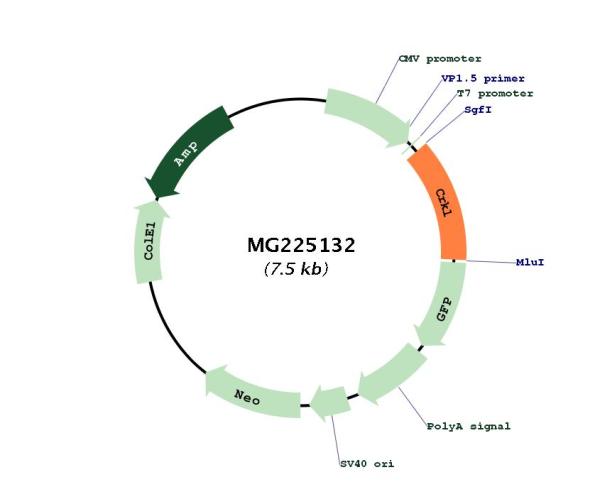Crkl (NM_007764) Mouse Tagged ORF Clone
CAT#: MG225132
- TrueORF®
Crkl (tGFP-tagged) - Mouse v-crk sarcoma virus CT10 oncogene homolog (avian)-like (Crkl), (10ug)
ORF Plasmid: DDK
Lentiviral Particles: DDK w/ Puro mGFP w/ Puro
AAV Particle: DDK
"NM_007764" in other vectors (4)
Specifications
| Product Data | |
| Type | Mouse Tagged ORF Clone |
| Tag | TurboGFP |
| Symbol | Crkl |
| Synonyms | 1110025F07Rik; AA589403; AI325100; Cr; Crkol; snoop |
| Vector | pCMV6-AC-GFP |
| E. coli Selection | Ampicillin (100 ug/mL) |
| Mammalian Cell Selection | Neomycin |
| Sequence Data |
>MG225132 representing NM_007764
Red=Cloning site Blue=ORF Green=Tags(s) TTTTGTAATACGACTCACTATAGGGCGGCCGGGAATTCGTCGACTGGATCCGGTACCGAGGAGATCTGCC GCCGCGATCGCC ATGTCCTCCGCCAGGTTTGATTCTTCAGACCGCTCTGCCTGGTACATGGGGCCAGTGACTCGCCAGGAGG CGCAGACTCGTCTCCAAGGCCAGCGCCATGGCATGTTCCTAGTCCGGGACTCATCTACCTGCCCCGGGGA CTATGTACTGTCCGTGTCCGAGAACTCGCGTGTCTCGCACTACATCATCAACTCCCTGCCCAACCGCCGC TTTAAGATCGGGGACCAGGAGTTTGACCATTTGCCGGCCTTGTTAGAGTTCTACAAGATCCACTACCTGG ACACTACCACCTTAATCGAACCGGCGCCCAGGTACCCAAGCCCACCAGTGGGTTCTGTCTCAGCACCCAA CTTACCTACAGCAGAAGAAAATCTGGAATATGTACGGACCCTTTATGATTTTCCTGGGAATGATGCTGAA GACCTACCCTTTAAAAAGGGCGAGCTTCTAGTGATAATAGAAAAGCCTGAAGAGCAGTGGTGGAGTGCCC GCAACAAGGACGGCCGGGTTGGGATGATTCCTGTCCCTTACGTTGAAAAGCTTGTGAGGTCTTCGCCACA TGGAAAGCATGGAAATAGGAATTCTAACAGTTATGGCATCCCAGAACCTGCTCATGCGTATGCTCAACCT CAGACCACAACTCCTCTACCTACAGTTGCCAGTACTCCTGGGGCAGCGATCAACCCTTTGCCATCCACAC AGAATGGACCTGTCTTTGCAAAAGCAATCCAGAAGAGAGTACCTTGTGCTTATGACAAGACTGCCTTGGC ATTGGAGGTTGGTGACATTGTGAAAGTCACAAGGATGAATATCAATGGCCAATGGGAAGGCGAGGTGAAT GGGCGCAAGGGGCTTTTCCCCTTCACACATGTTAAAATCTTTGACCCTCAGAACCCCGATGACAACGAG ACGCGTACGCGGCCGCTCGAG - GFP Tag - GTTTAA >MG225132 representing NM_007764
Red=Cloning site Green=Tags(s) MSSARFDSSDRSAWYMGPVTRQEAQTRLQGQRHGMFLVRDSSTCPGDYVLSVSENSRVSHYIINSLPNRR FKIGDQEFDHLPALLEFYKIHYLDTTTLIEPAPRYPSPPVGSVSAPNLPTAEENLEYVRTLYDFPGNDAE DLPFKKGELLVIIEKPEEQWWSARNKDGRVGMIPVPYVEKLVRSSPHGKHGNRNSNSYGIPEPAHAYAQP QTTTPLPTVASTPGAAINPLPSTQNGPVFAKAIQKRVPCAYDKTALALEVGDIVKVTRMNINGQWEGEVN GRKGLFPFTHVKIFDPQNPDDNE TRTRPLE - GFP Tag - V |
| Restriction Sites |
SgfI-MluI
Cloning Scheme for this gene
Plasmid Map

|
| ACCN | NM_007764 |
| ORF Size | 909 bp |
| OTI Disclaimer | The molecular sequence of this clone aligns with the gene accession number as a point of reference only. However, individual transcript sequences of the same gene can differ through naturally occurring variations (e.g. polymorphisms), each with its own valid existence. This clone is substantially in agreement with the reference, but a complete review of all prevailing variants is recommended prior to use. More info |
| OTI Annotation | This clone was engineered to express the complete ORF with an expression tag. Expression varies depending on the nature of the gene. |
| Product Components | The ORF clone is ion-exchange column purified and shipped in a 2D barcoded Matrix tube containing 10ug of transfection-ready, dried plasmid DNA (reconstitute with 100 ul of water). |
| Reconstitution | 1. Centrifuge at 5,000xg for 5min. 2. Carefully open the tube and add 100ul of sterile water to dissolve the DNA. 3. Close the tube and incubate for 10 minutes at room temperature. 4. Briefly vortex the tube and then do a quick spin (less than 5000xg) to concentrate the liquid at the bottom. 5. Store the suspended plasmid at -20°C. The DNA is stable for at least one year from date of shipping when stored at -20°C. |
| Reference Data | |
| RefSeq | NM_007764.5, NP_031790.2 |
| RefSeq Size | 3863 bp |
| RefSeq ORF | 912 bp |
| Locus ID | 12929 |
| UniProt ID | P47941 |
| Cytogenetics | 16 A3 |
| Gene Summary | This gene is part of a family of adapter proteins that mediate formation of signal transduction complexes in response to extracellular stimuli, such as growth and differentiation factors. Protein-protein interactions occur through the SH2 domain, which binds phosphorylated tyrosine residues, and the SH3 domain, which binds proline-rich peptide motifs. These interactions promote recruitment and activation of effector proteins to regulate cell migration, adhesion, and proliferation. In certain mouse genetic backgrounds this protein is essential for embryonic development. It is important for neural crest cell differentiation and survival and is proposed to play an important role in transducing the oncogenic signal of Bcr/Abl. Deletion of this gene in mouse mimics the phenotype of DiGeorge/velocardiofacial syndrome in human. Alternative splicing results in multiple transcript variants that encode different protein isoforms. [provided by RefSeq, Mar 2013] |
Documents
| Product Manuals |
| FAQs |
| SDS |
Resources
Other Versions
| SKU | Description | Size | Price |
|---|---|---|---|
| MC208335 | Crkl (untagged) - Mouse v-crk sarcoma virus CT10 oncogene homolog (avian)-like (Crkl), (10ug) |
USD 330.00 |
|
| MR225132 | Crkl (Myc-DDK-tagged) - Mouse v-crk sarcoma virus CT10 oncogene homolog (avian)-like (Crkl) |
USD 300.00 |
|
| MR225132L3 | Lenti ORF clone of Crkl (Myc-DDK-tagged) - Mouse v-crk sarcoma virus CT10 oncogene homolog (avian)-like (Crkl) |
USD 600.00 |
|
| MR225132L4 | Lenti ORF clone of Crkl (mGFP-tagged) - Mouse v-crk sarcoma virus CT10 oncogene homolog (avian)-like (Crkl) |
USD 600.00 |
{0} Product Review(s)
Be the first one to submit a review






























































































































































































































































 Germany
Germany
 Japan
Japan
 United Kingdom
United Kingdom
 China
China

